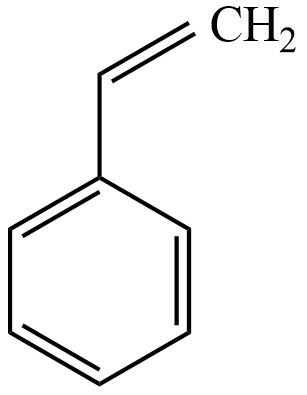
Alkaline

(A) unsaturation in side-chain affected
(B) unsaturation in benzene nucleus is affected
(C) unsaturation in both is affected
(D) Bayer’s reagent cannot be used

Answer
489.9k+ views
Hint: The alkynes and alkenes are coming under unsaturated hydrocarbons. In organic chemistry, there are many tests to identify the presence of unsaturated in hydrocarbons. The alkaline potassium permanganate test (Baeyer’s test) and bromine test are the methods for detecting the unsaturation in an organic compound.
Complete step by step answer:
Baeyer’ reagent, which is an alkaline solution of cold potassium permanganate (
When this Baeyer’s reagent interacts with unsaturated compounds changing its pinkish-purple color to brown, because of the alkenes are oxidized to 1,2-diol and the permanganate is reduced to manganese dioxide(
The test does not work for alkanes and aromatic compounds, and hence, this Baeyer’s test is used to distinguish them from alkenes and alkynes.
So, Alkaline
So, the correct answer is “Option A”.
Note: Baeyer’s reagent has more applications in medical purpose, in water treatment, synthesis of organic compounds, analytical methods, fruit preservation, survival kits, and fire service. Potassium permanganate dissolves in water to give intense pink or purple solutions and leaves purplish-black crystals on evaporation.
Complete step by step answer:
Baeyer’ reagent, which is an alkaline solution of cold potassium permanganate (
When this Baeyer’s reagent interacts with unsaturated compounds changing its pinkish-purple color to brown, because of the alkenes are oxidized to 1,2-diol and the permanganate is reduced to manganese dioxide(
The test does not work for alkanes and aromatic compounds, and hence, this Baeyer’s test is used to distinguish them from alkenes and alkynes.
So, Alkaline
So, the correct answer is “Option A”.
Note: Baeyer’s reagent has more applications in medical purpose, in water treatment, synthesis of organic compounds, analytical methods, fruit preservation, survival kits, and fire service. Potassium permanganate dissolves in water to give intense pink or purple solutions and leaves purplish-black crystals on evaporation.
Latest Vedantu courses for you
Grade 11 Science PCM | CBSE | SCHOOL | English
CBSE (2025-26)
School Full course for CBSE students
₹41,848 per year
Recently Updated Pages
Master Class 9 General Knowledge: Engaging Questions & Answers for Success

Master Class 9 English: Engaging Questions & Answers for Success

Master Class 9 Science: Engaging Questions & Answers for Success

Master Class 9 Social Science: Engaging Questions & Answers for Success

Master Class 9 Maths: Engaging Questions & Answers for Success

Class 9 Question and Answer - Your Ultimate Solutions Guide

Trending doubts
Give 10 examples of unisexual and bisexual flowers

Draw a labelled sketch of the human eye class 12 physics CBSE

Differentiate between homogeneous and heterogeneous class 12 chemistry CBSE

Differentiate between insitu conservation and exsitu class 12 biology CBSE

What are the major means of transport Explain each class 12 social science CBSE

a Tabulate the differences in the characteristics of class 12 chemistry CBSE




